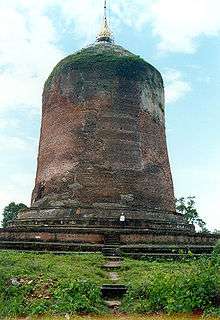Burmese pagoda
Burmese pagodas are stupas that typically house Buddhist relics, including relics associated with Buddha.[1] Pagodas feature prominently in Myanmar's landscape, earning the country the moniker "land of pagodas."[2] According to 2016 statistics compiled by the State Sangha Maha Nayaka Committee, Myanmar is home to 1,479 pagodas exceeding 27 feet (8.2 m) in height, a quarter of which are located in Sagaing Region.[3] Several cities in the country, including Mandalay and Bagan, are known for their abundance of pagodas. Pagodas are the site of seasonal pagoda festivals.[4]

Burmese pagodas are enclosed in a compound known as the aran (အာရာမ်, from Pali ārāma), with gateways called mok (မုခ်, from Pali mukha) at the four cardinal directions. The platform surrounding a Burmese pagoda is called a yinbyin (ရင်ပြင်).
Terms

In the Burmese language, pagodas are known by a number of various terms. The umbrella term phaya (ဘုရား, pronounced [pʰəjá]), which derives from Sanskrit vara,[5] refers to pagodas, images of the Buddha, as well as royal and religious personages, including the Buddha, kings, and monks.[6] Zedi (စေတီ), which derives from Pali cetiya, specifically refers to typically solid, bell-shaped stupas that may house relics.[7] Pahto (ပုထိုး) refers to hollow square or rectangular buildings built to resemble caves, with chambers that house images of the Buddha.[1][7] Burmese pagodas are distinguished from kyaungs in that the latter are monasteries that house Buddhist monks.
Types
Burmese zedis are classified into four prevalent types:
- Datu zedi (ဓာတုစေတီ, from Pali dhātucetiya) or datdaw zedi (ဓာတ်တော်စေတီ) - zedis enshrining relics of the Buddha or arhats[8]
- Paribawga zedi (ပရိဘောဂစေတီ, from Pali paribhogacetiya) - zedis enshrining garments and other items (alms bowls, robes, etc.) that belonged to the Buddha or sacred personages[8]
- Dhamma zedi (ဓမ္မစေတီ, from Pali dhammacetiya) - zedis enshrining sacred texts and manuscripts, along with jewels and precious metals[8]
- Odeiktha zedi (ဥဒ္ဒိဿစေတီ, from Pali uddissacetiya) - zedis built from motives of piety, containing statues of the Buddha, models of sacred images[8]
Of the four classes, dhammazedis and udeikthazedis are the most prevalent, since they are routinely erected by donors as a work of merit.[8] Burmese zedis are typically constructed with bricks, covered with whitewashed stucco.[8] Prominent zedis are gilded with gold.[8] Burmese zedis are crowned with a spired final ornament known as the hti, which is hoisted in a traditional ceremony (ထီးတော်တင်ပွဲ, htidaw tin pwe) that dates to the pre-colonial era.[9][10]
See also
- Buddhism in Burma
- Stupa
- Cetiya
- Pagoda
- Pagoda festival
References
- Seekins, Donald M. (2006). Historical Dictionary of Burma (Myanmar). Scarecrow Press. ISBN 9780810864863.
- Thurber, Robert Bruce (1921). In the Land of Pagodas. Southern Pub. Association.
- "The Account of Pagodas and Stupas which are over 27 feet height". The State Samgha Maha Nayaka Committee. Retrieved 2020-05-19.
- Thurber, Robert Bruce (1921). In the Land of Pagodas. Southern Pub. Association.
- Myanmar-English Dictionary. Myanmar Language Commission. 1993. ISBN 1-881265-47-1.
- Suan, Pau, Cope (2015). "Reflecting the Missio - Logoi of the First Overseas American Missionary". Papers. 1.
- Reid, Robert; Grosberg, Michael (2005). Myanmar (Burma). Lonely Planet. ISBN 9781740596954.
- Hardiman, John Percy (1900). Gazetteer of Upper Burma and the Shan States. Superintendent, Government printing, Burma.
- Scott, James George (1910). The Burman, his life and notions. London Macmillan.
- Langfield, Michele; Logan, William; Craith, Mairead Nic (2009). Cultural Diversity, Heritage and Human Rights: Intersections in Theory and Practice. Routledge. ISBN 9781135190705.
External links
| Wikimedia Commons has media related to Pagodas in Myanmar. |